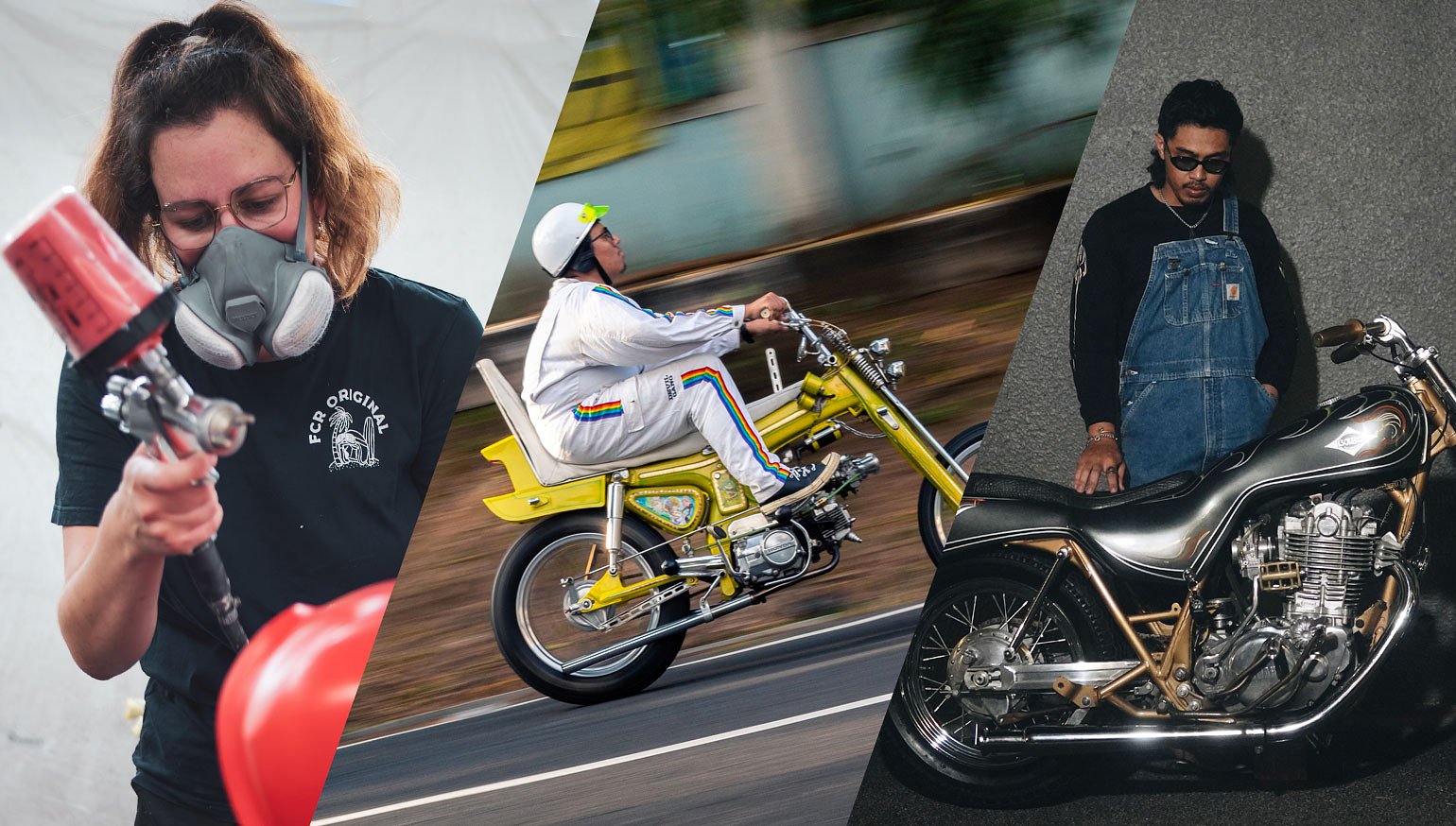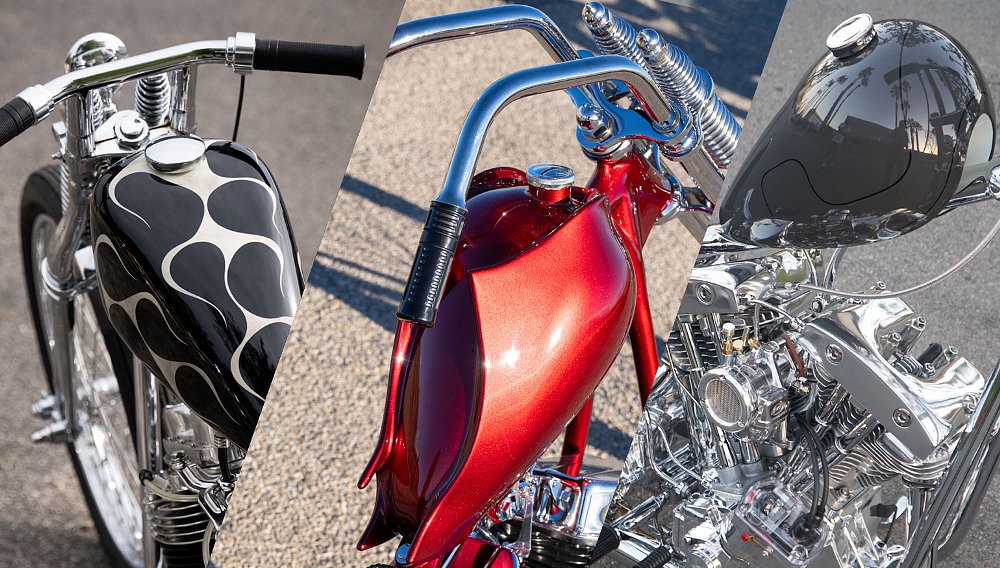In this month's edition of the custom roundup: Triumph challenges an international lineup of dealerships to customize its iconic Bonneville, and we take a look at what the French came up with. A Yamaha SR400 featuring a look inspired by a 1960s surfboard fabricator turned custom motorcycle bodywork maker. And we delve into the world of "Choppy Cubs" with a zany build out of Indonesia.
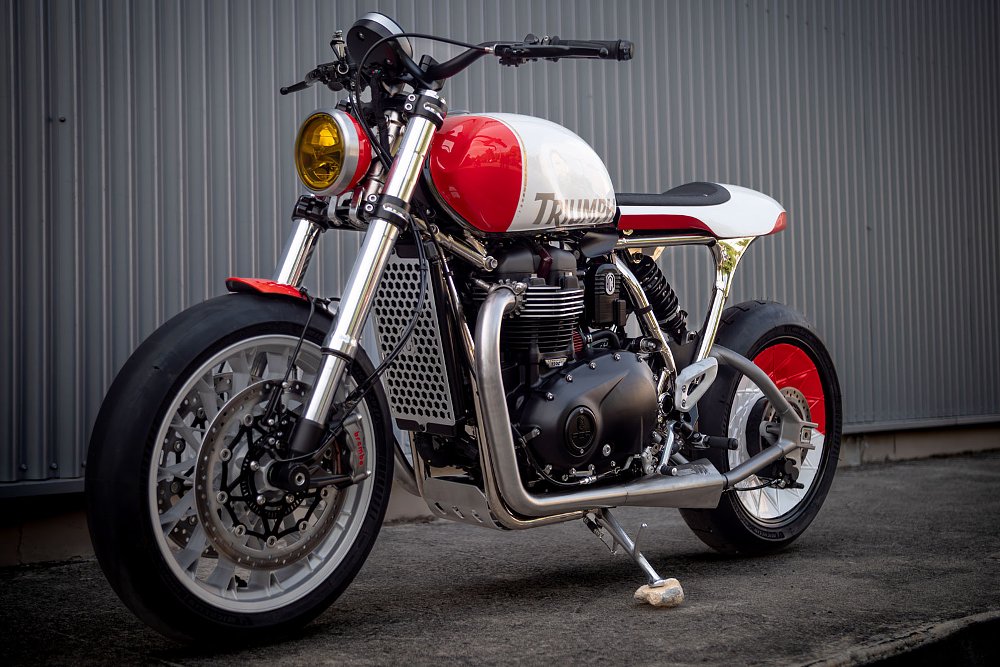
FCR Original "Hail to the Twin" Speed Twin RS
Triumph's Bonneville has a long and storied past spanning more than 65 years. In recognition of its most iconic model, the British marque has launched the Triumph Originals challenge, a build-off-style competition celebrating innovation and creativity.
Taking part in the challenge are eight dealership-based teams from the UK, U.S.A., Canada, Mexico, Brazil, France, Italy, and Thailand. Each has been tasked with creating a bike based on a model from the current Bonneville range in conjunction with a local custom workshop. For their entry into the challenge, team France joined forces with custom powerhouse FCR Original (Instagram).
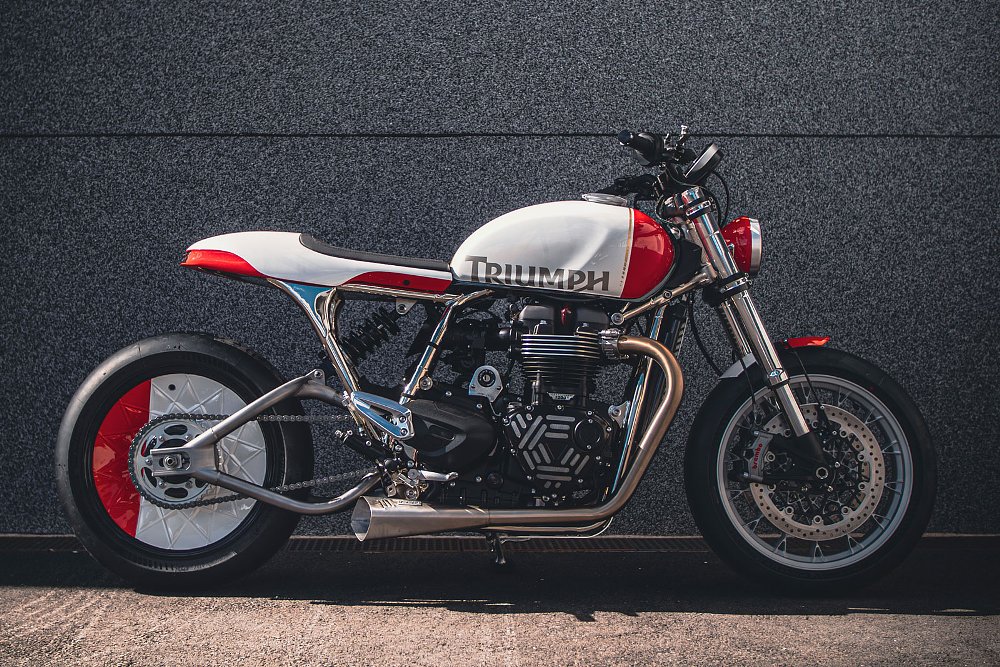
"This project symbolizes the encounter between the vision of an independent company and the influence of an iconic brand like Triumph," says Max Lellouch of FCR. "This bike is the work of a passionate and committed team. Each of them has put his or her expertise at the service of a common goal: to create a radical, elegant, and high-performance Triumph."
Nicknamed the "Hail to the Twin" project, the bike started life as a Triumph Speed Twin 1200 RS. Visually, its silhouette isn't all that dissimilar to the original bike, but a closer look reveals some significant differences.
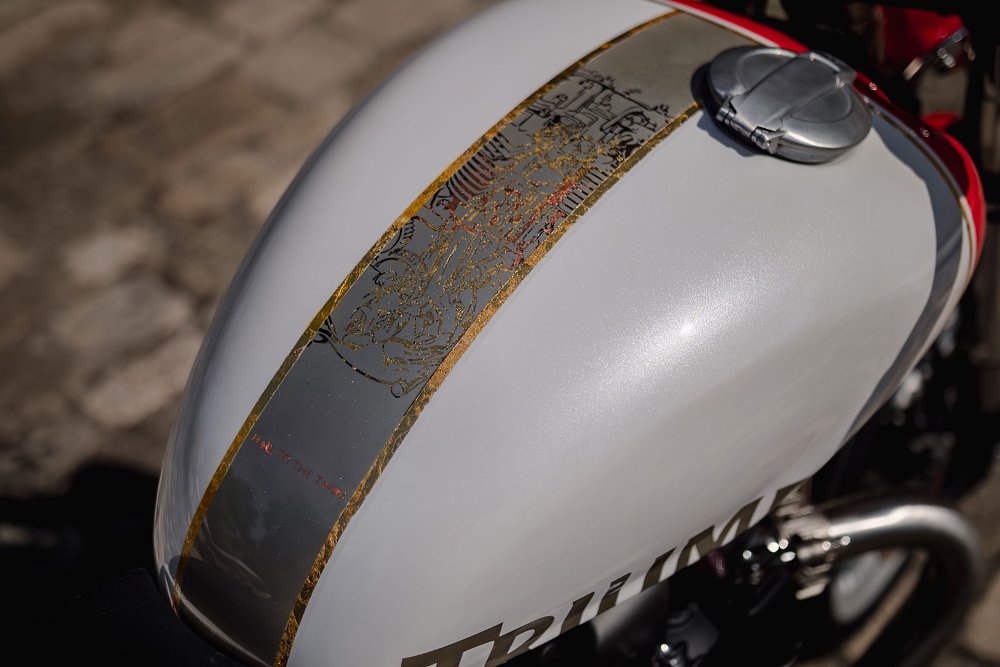
The bike's bodywork is a mix of original and bespoke components. The fuel tank, although stock, wears striking custom pearl paint and gold and copper leaf details. The front fender is a svelte custom carbon fiber creation, and the 3D-designed seat and tail unit with integrated lighting are bespoke, too. The front end has been treated to a low-slung handlebar, lowered fork, a compact LED headlight, and to keep things looking clean, they've relocated the ignition to the side of the engine.
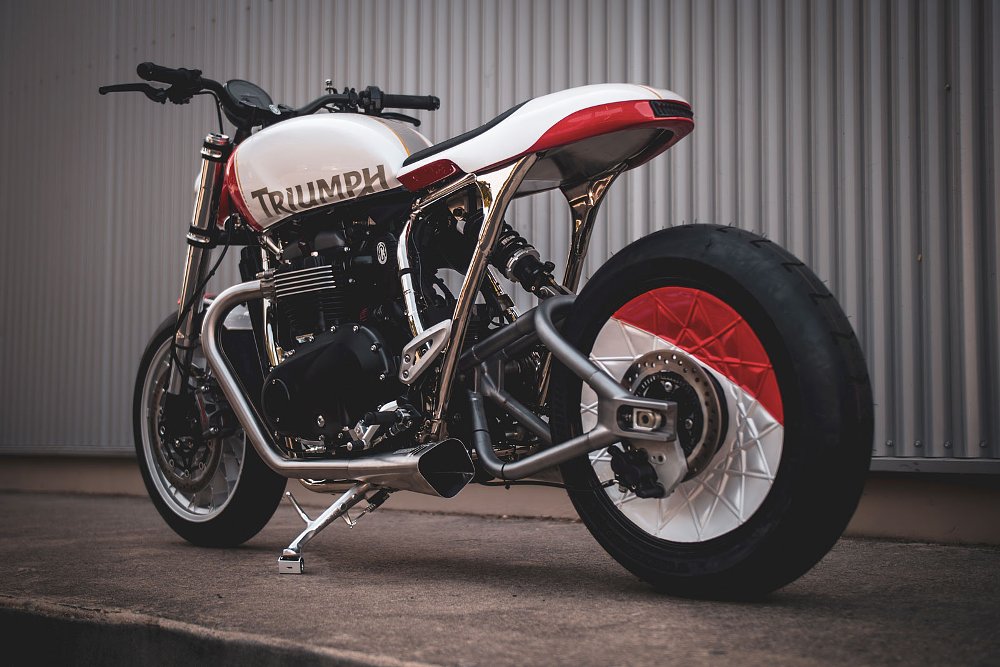
The rear of this Speed Twin's chassis is where the most dramatic structural changes took place. After cutting away the subframe, FCR welded a custom hoop in its place. The factory swingarm was given the flick, too, allowing the fitment of a billet machined alternative and the conversion to a monoshock setup. To shed some unsprung weight, FCR created one-off billet wheels and wrapped the rear in carbon covers. To then give the Speed Twin's parallel twin a unique look, they acid-etched the covers.
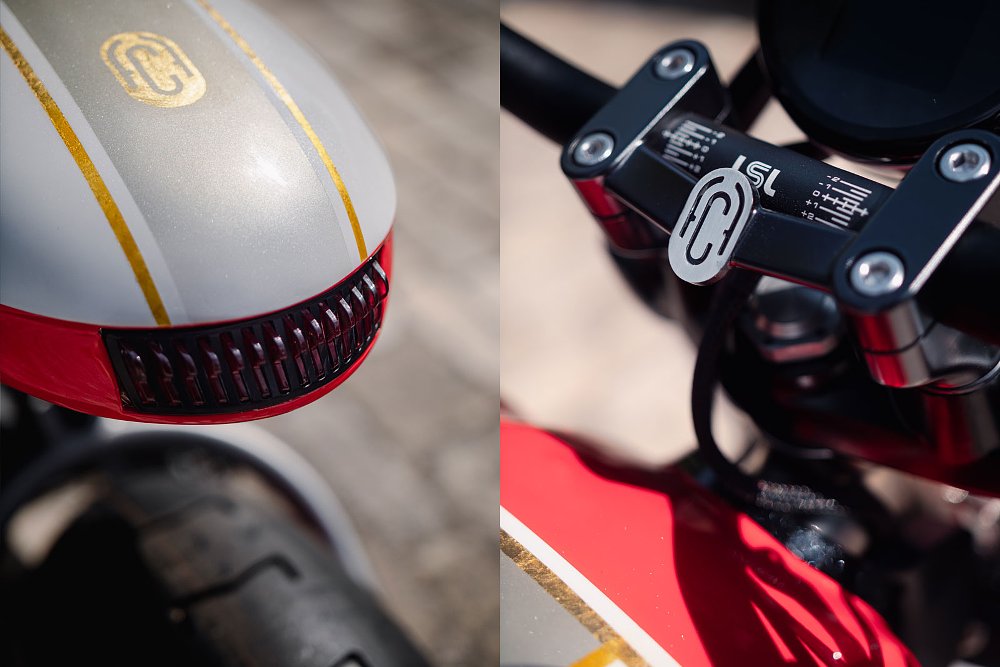
Completing the look of FCR's Speed Twin are simplified controls and a CNC-milled mount for the gauge. Leaving no stone unturned, FCR has also unleashed additional horses from the Brit twin with the fitment of a direct intake, K&N filters, a custom two-into-two titanium exhaust, and an ECU flash.
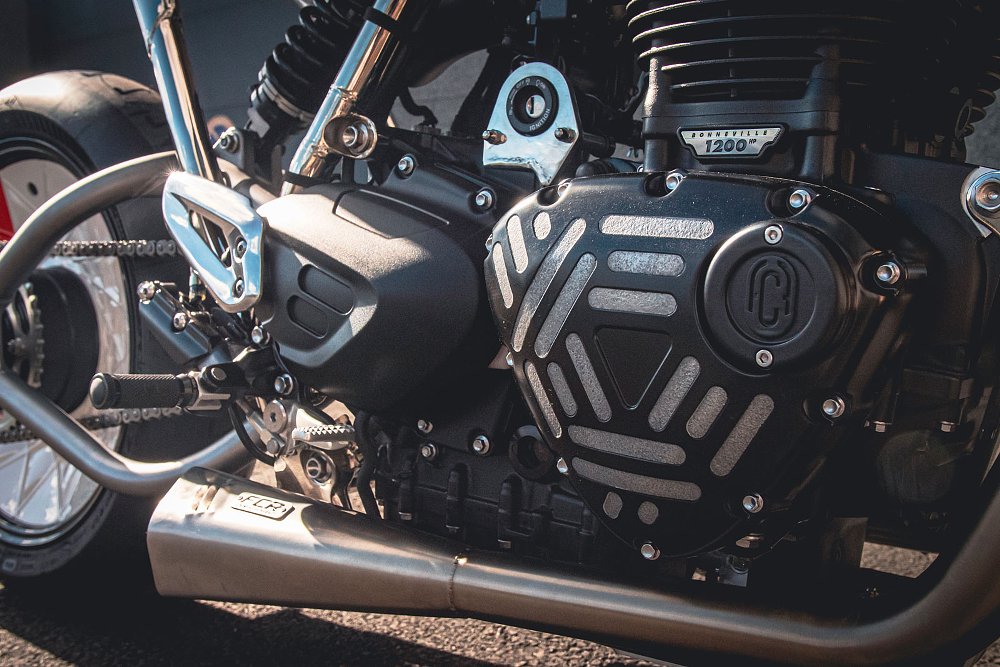
To make this bike possible, it was all hands on deck at FCR HQ, and the result speaks volumes of their abilities. If you'd like to see the seven other entries in the Triumph Originals challenge, you can view them here.
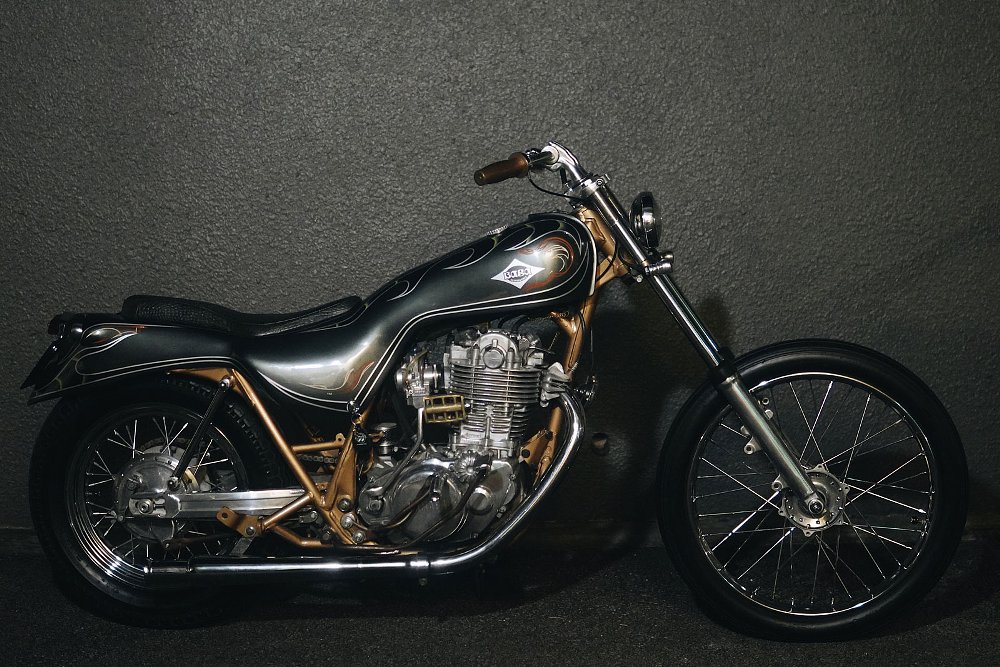
BAGA Kustomwerks Yamaha SR400
In the 1960s, California was riding the peak of a cultural wave. Surfing had become a full-blown movement, and surfboard brands were shelling out big money to skilled fiberglass workers. One talented shaper enjoying the fruits of the scene was a craftsman by the name of Tracy Nelson. But while others were focusing solely on boards, he had his eyes set on a different horizon.
In addition to surfing, custom motorcycles were in vogue, and Tracy had the foresight to tap into it. In his spare time, he began designing and shaping sleek, futuristic body kits that would transform an ordinary motorcycle into a psychedelic road tripper. His venture, Tracy's Fiberglas Works, went on to become one of America's largest and most influential motorcycle body kit manufacturers.
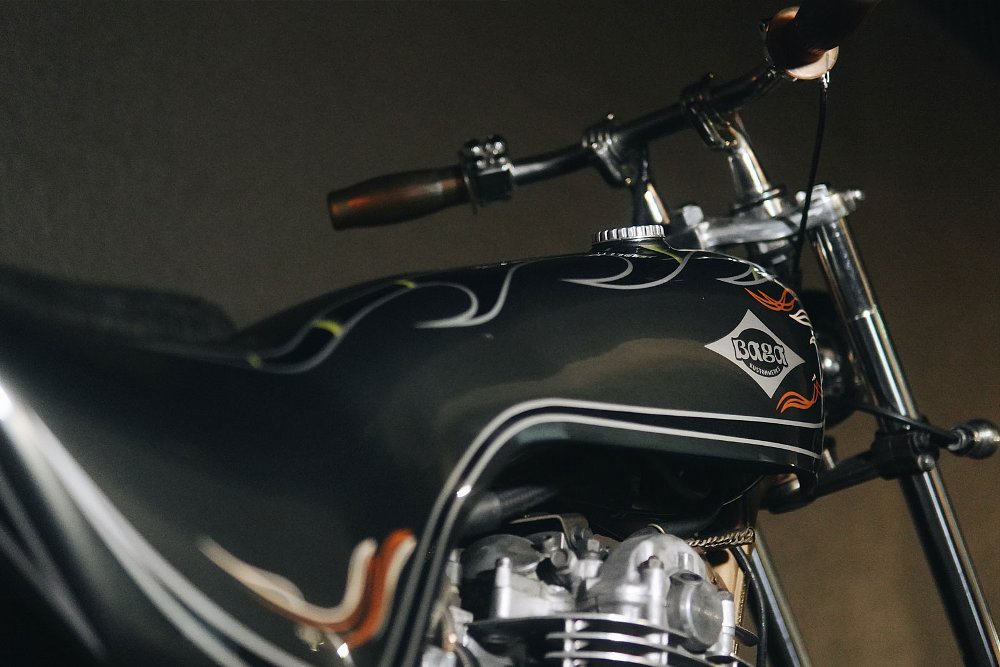
Although Tracy's Fiberglas Works has long since closed its doors, its influence on the custom scene lives on. Case in point, this Tracy Works-inspired Yamaha SR400 by Singaporean builder Shah Danial.
Shah works as an experienced aircraft engine technician by day, but in his spare time, he turns his attention to motorcycles. What began as a personal passion, building a few bikes for himself, quickly grew into crafting custom machines for friends. Before long, his work caught the eye of local riders, leading to requests for commissioned builds. This natural progression gave rise to his own workshop: BAGA Kustomwerks.
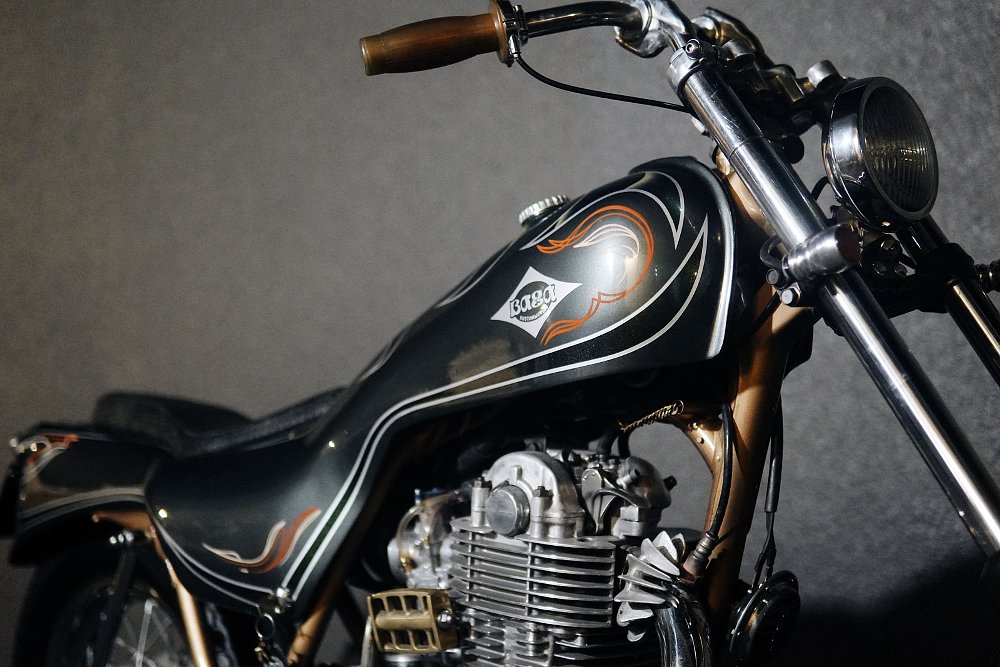
"This SR400 has been my personal ride since 2023, and it's been through four different transformations — starting as a café racer with custom fairings, then a British classic, then a chopper, and now its final form: a Tracy-inspired chopper," Shah recalls. "The SR400's versatility made each transformation possible, but this one really feels like its true identity."
Shah's decision to make this the final iteration of his ongoing SR400 project boils down to his impression of the bike's chassis. The lines of the SR's OIF semi-double-cradle frame never appealed to his aesthetic, but rather than cutting into it, he decided to simply hide it away under bodywork. During his search for a viable solution, he stumbled across the work of Tracy's Fiberglas and decided to create his own.

After studying photos of Tracy's body kits, Shah settled on a style and began sourcing parts to recreate the look. The Frankenstein mix of components he gathered included an FRP vintage teardrop tank from Goods in Japan, a basic aftermarket rear fender, and a set of side covers salvaged from his scrap parts bin. He then set to work merging the pieces by laying fiberglass directly over them, with the goal of creating a single, seamless structure. Once the general shape was established, he refined and finessed until he was completely satisfied with the result. For a suitably offbeat finish, the seat Shah built for the body was wrapped in dark green crocodile skin.
"As I built the bodywork, I kept thinking something was missing," says Shah. "I turned to retro car designs for inspiration and became obsessed with all the clean, integrated tail lights. That led me to design built-in signal lights for the rear end."

Another crucial element of any BAGA build is stance. To get his SR sitting just right, Shah converted the wheels to a 21-inch front and 16-inch rear combination. In addition, he extended the fork by four inches and lowered the rear by 2.5 inches. This approach gave the bike a chopper-like stance without the need to modify the stock frame. A set of custom footpegs, crafted from twisted metal rods, along with a swept-back handlebar mounted in risers, set up the optimal riding position. The lack of controls on the handlebar is a result of a hand-shift conversion.
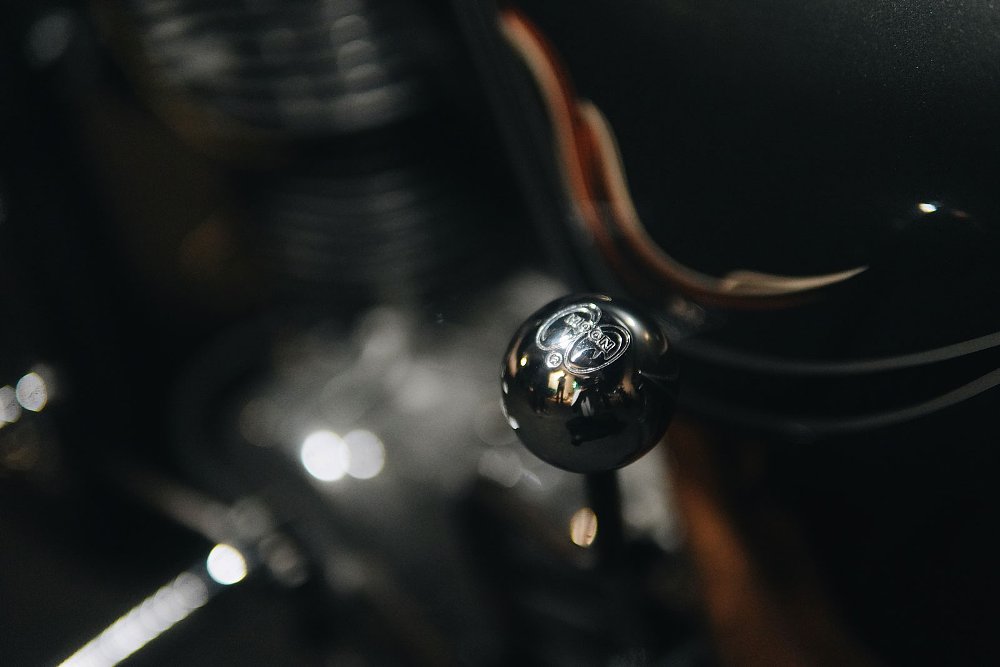
To complete the bodywork, Shah turned to his go-to painter, Ah Huat, who laid down the gunmetal basecoat. Artist Hara then added hand-laid pinstriping in classic '60s style. By pure coincidence, the wave pattern on the bodywork was inspired by Shah's love of surfing, not by his knowledge of Tracy Nelson's surfing roots. In a way, this final iteration of Shah's SR400 feels predestined, and I'm sure Tracy himself would approve of the result.
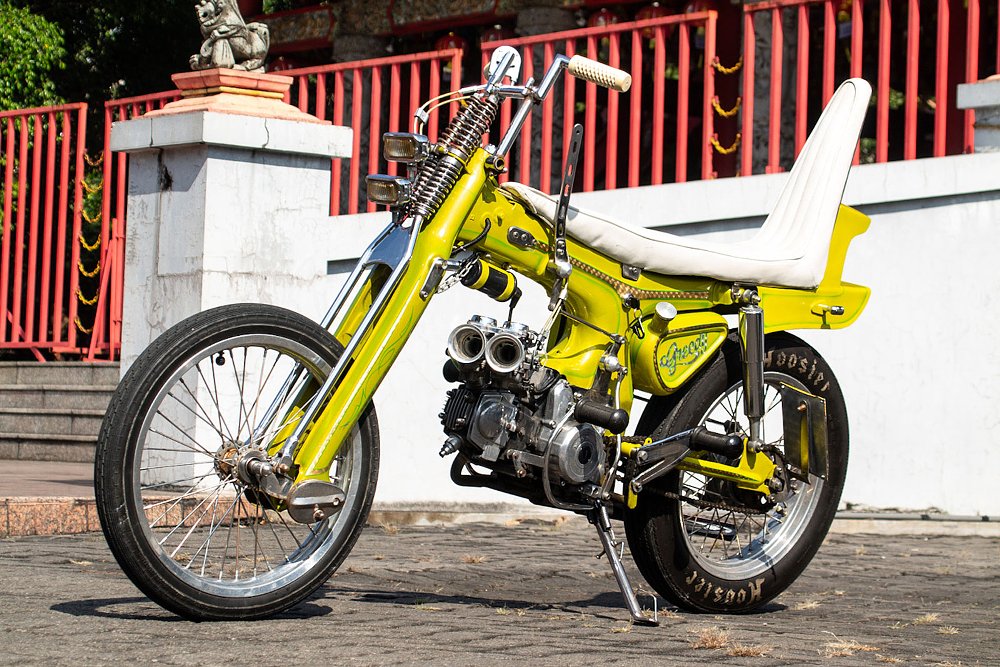
"Greedy" Honda C100 by Radite Octavanka
A "Choppy Cub" is what happens when the world's most practical little motorcycle gets a rebellious streak. The best-selling Honda Cub is renowned for being an affordable, lightweight, and bulletproof commuter. In most cases, it's used to carry groceries, kids, or just about anything else you could strap to it. But somewhere along the way, a Japanese Cub enthusiast thought, "What if I turned it into a chopper?" That spark of madness gave birth to the Choppy Cub, a low-slung, stretched custom that takes cues from the chopper scene. After taking Japan by storm, the Choppy Cub trend spread across Southeast Asia to Thailand, Indonesia, and Vietnam, kickstarting a full-blown custom Cub trend.
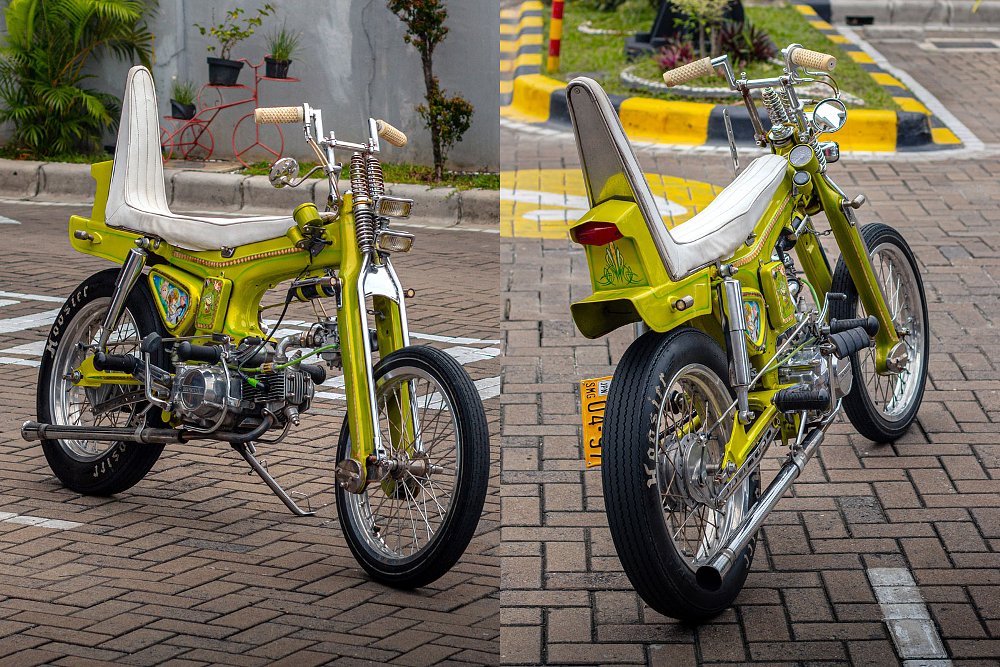
Radite Octavanka, of Indonesia's Raxe97ninetyseven, is a big fan of Choppy Cub culture. The digital designer has made a living designing motorcycles for other workshops. But on occasion, he likes to build a bike of his own with the help of his father, who also happens to have a custom workshop. This time around, Radite wanted to build his own interpretation of a Choppy Cub.
"The engine is from a Honda C100, otherwise known as a Supra X in Indonesia, and for the frame I used a Honda S90 chassis with custom engine mounting brackets," he explains. "The engine was left over from a client project, so Dad and I decided to make a custom with one of the past designs I'd rendered on my laptop."
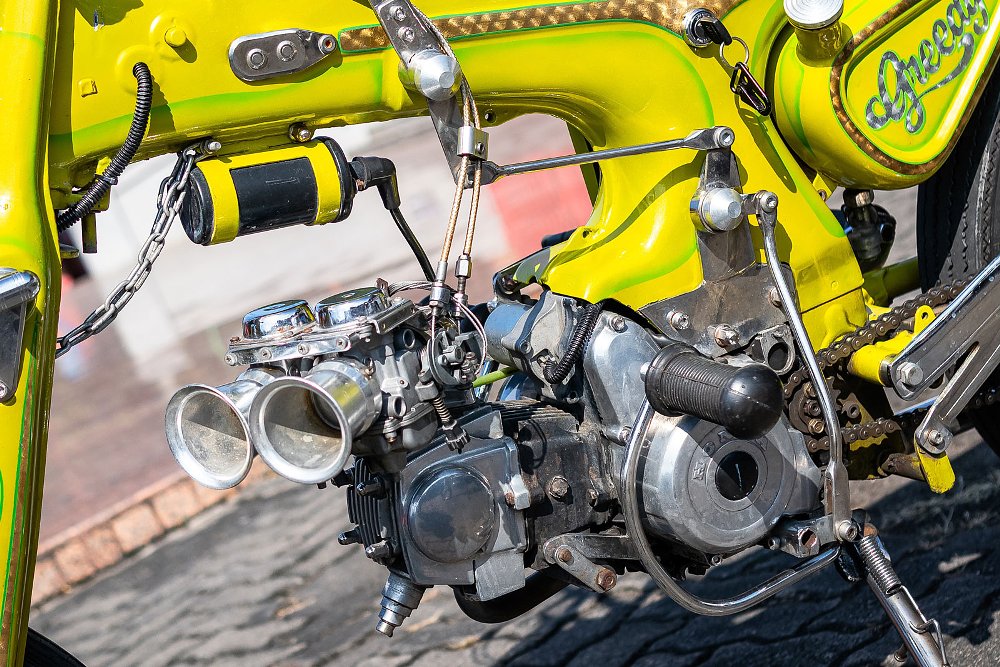
As a designer/builder, Radite always tries to put a different spin on his work, so he decided go against the typical Choppy Cub frame choice of a C70, opting for the S90 chassis, instead. The big difference is that the S90 unit is a fully pressed steel construction, while the C70 has a tubular backbone connected to a pressed chassis. This choice resulted in a stockier, more compact-looking chop.
Radite's seat is a mix of Japanese and American custom culture. The white leather banana seat was influenced by the Bosozoku riders in Japan. As for the rear fender, it harkens back to the "Crazy Frank" fenders seen in U.S. chopper culture. Further emphasizing the chopper styling is a one-off springer front end made using a Honda C70 fork. The final bit of external inspiration came from of a jockey shifter, styled after one he saw in a car belonging to New Zealand drift racer Mad Mike.
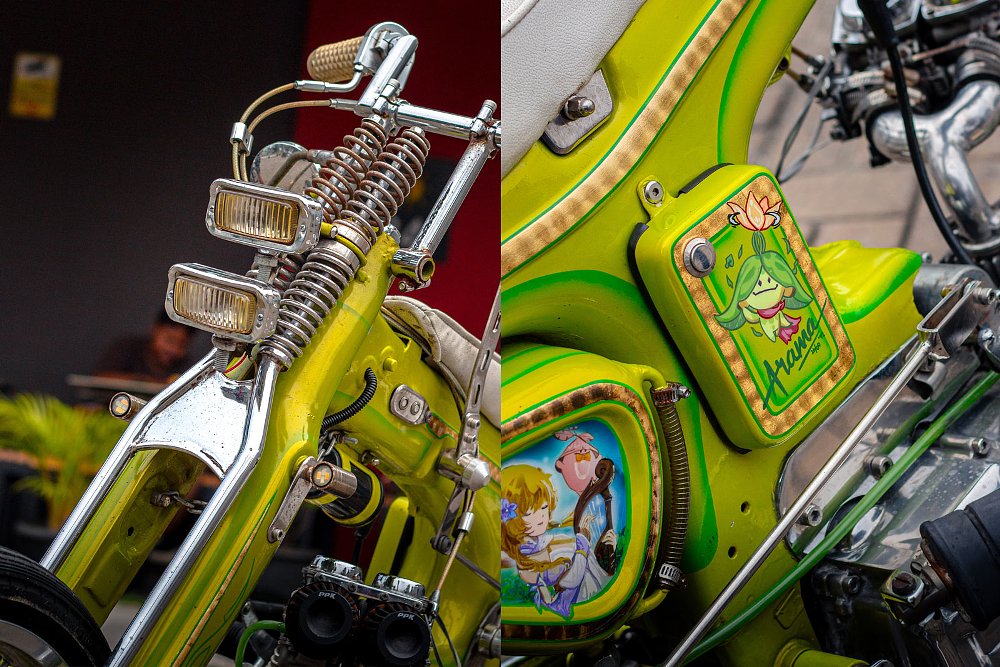
As for the rest of the build, Radite says it evolved naturally, with many of the parts requiring custom fabrication. Examples include the Z-style handlebar, Honda Rebel double carb setup, a mid-mounted gas tank that sits under the seat, a bespoke swingarm to accommodate his rear wheel choice, and the one-off exhaust.
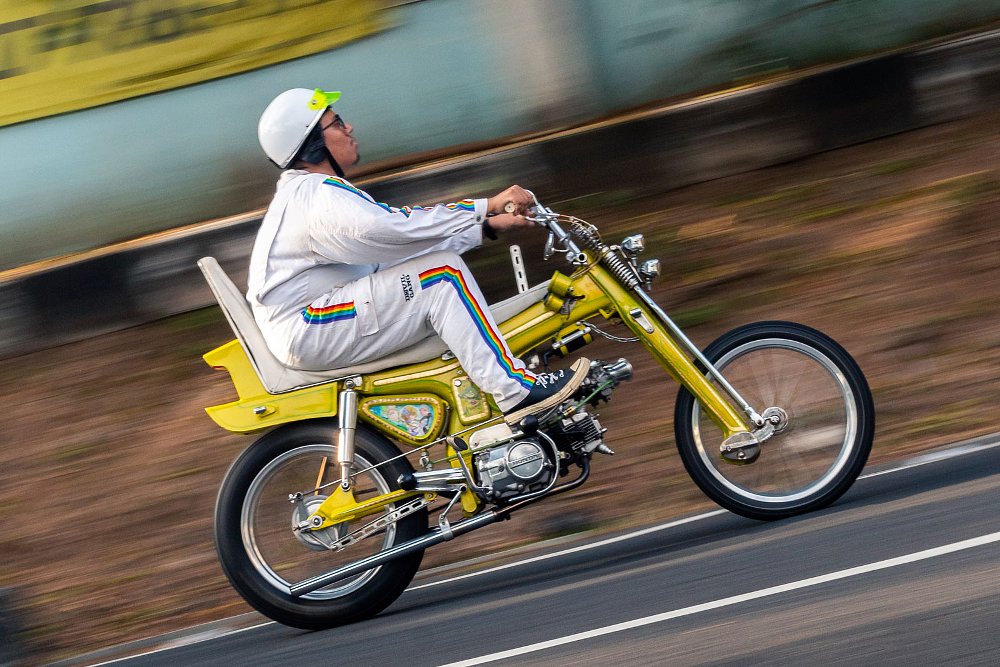
After completing his Choppy Cub Radite, he entered the bike into Indonesia's foremost custom automotive event, Kustomfest. Unsurprisingly, the bike caught the eye of the judges, and Masa of Luck MC in Japan awarded him best of show in the Choppy Cub category.

 Membership
Membership

